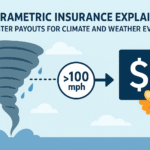The Importance of Flood Insurance and Climate Resilience Strategies
Flooding is a natural disaster that can have devastating consequences for communities and individuals. With the increasing frequency and severity of extreme weather events due to climate change, it has become more important than ever to have effective flood insurance and climate resilience strategies in place.
Understanding Flood Insurance
Flood insurance is a type of insurance coverage that protects property owners from financial loss due to flood damage. Unlike other types of insurance, such as homeowners insurance, flood insurance specifically covers damage caused by flooding.
One of the key reasons why flood insurance is important is that most standard homeowners insurance policies do not cover flood damage. Without flood insurance, property owners may be left to bear the full cost of repairing or rebuilding their homes and replacing damaged belongings.
Flood insurance is typically offered through the National Flood Insurance Program (NFIP) in the United States. This program is administered by the Federal Emergency Management Agency (FEMA) and provides affordable flood insurance to property owners in flood-prone areas.
The Benefits of Flood Insurance
Having flood insurance offers several benefits, including:
- Financial Protection: Flood insurance provides financial protection against the high costs of repairing or rebuilding after a flood. It can help cover the costs of structural damage, as well as damage to personal belongings.
- Peace of Mind: Knowing that you have flood insurance can provide peace of mind, especially if you live in an area prone to flooding. It allows you to focus on the safety of yourself and your loved ones during a flood event, rather than worrying about the financial implications.
- Community Resilience: By having flood insurance, communities can bounce back more quickly after a flood event. This can help reduce the overall economic impact of flooding and aid in the recovery process.
Climate Resilience Strategies
In addition to flood insurance, implementing climate resilience strategies is crucial for mitigating the impacts of flooding and building more resilient communities. These strategies focus on adapting to and preparing for the effects of climate change, including increased flooding.
Some effective climate resilience strategies include:
- Improved Infrastructure: Investing in infrastructure improvements, such as upgrading drainage systems and building flood barriers, can help reduce the risk of flooding and minimize damage when floods do occur.
- Natural Flood Control Measures: Implementing natural flood control measures, such as restoring wetlands and creating green spaces, can help absorb excess water and reduce the risk of flooding.
- Land Use Planning: Implementing smart land use planning strategies, such as avoiding building in flood-prone areas and preserving natural floodplains, can help minimize the exposure to flood risk.
- Education and Awareness: Educating communities about flood risks and promoting awareness of flood preparedness measures can help individuals and communities be better prepared for flooding events.
- Collaboration and Coordination: Foster collaboration and coordination among government agencies, community organizations, and stakeholders to develop comprehensive flood management plans and strategies.
Conclusion
Flood insurance and climate resilience strategies are essential in today’s world to protect communities and individuals from the increasing risks associated with flooding and climate change. While flood insurance provides financial protection, climate resilience strategies help to reduce the vulnerability of communities and build a more resilient future.
By combining the benefits of flood insurance with effective climate resilience strategies, we can work towards minimizing the impact of flooding and ensuring the long-term sustainability and well-being of our communities.










